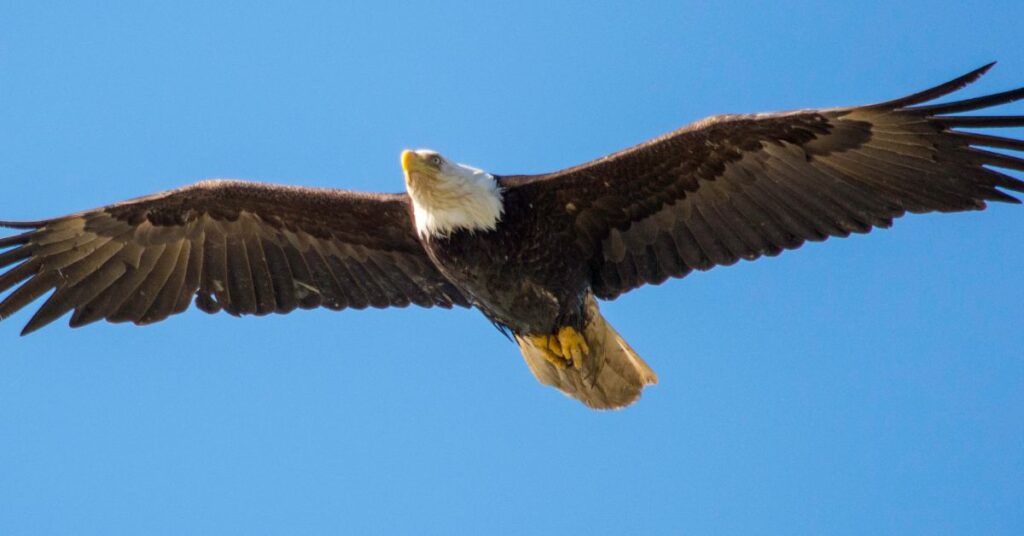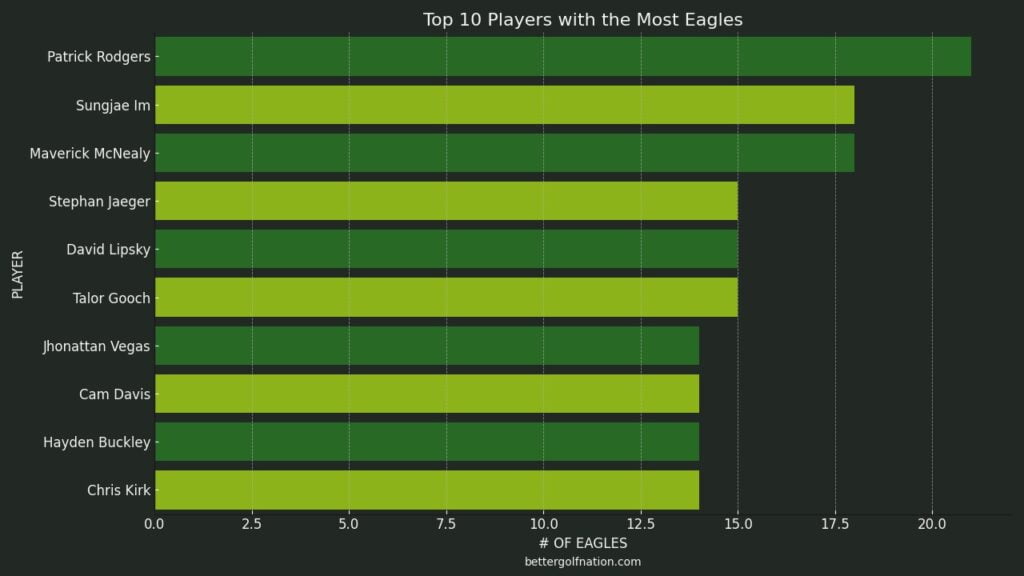Guide to Golf’s Golden Eagle: Scoring an Eagle in Golf
An eagle in golf signifies a player mastering a hole two strokes under par, a rare feat often achieved on par-4 or par-5 holes. This term, emerging after “birdie,” symbolizes an exceptional performance, requiring preparation, skill, and confidence. Although a challenging accomplishment, it brings an unforgettable thrill to your golfing journey.

Golf enthusiasts, aficionados, and players all agree on one thing: the aim of the game is to perform at your best, securing the lowest score possible. Consistency is the key, and the dream of many golfers is to achieve an elusive eagle.
But what exactly does that mean? And why does it set hearts racing among those fortunate enough to accomplish it?
An eagle in golf is when a player masters a hole two strokes under par, a rare and extraordinary achievement. Although theoretically possible on any type of hole, eagles most commonly occur on par-4 or par-5 holes. This term has been entrenched in golf terminology for ages and is a testament to an exceptional performance on the fairways.
The term “eagle” followed the invention of “birdie“(what is a birdie, read here), which happened in the late 19th century in America. A “birdie” refers to finishing a hole one stroke under par, a remarkable feat in itself. It signifies the ball flying bird-like towards the hole. As the bird theme continued, the “eagle” was born, symbolizing an even more significant accomplishment, akin to the powerful, majestic predator ruling the skies.
"An eagle in golf is when a player masters a hole two strokes under par, a rare and extraordinary achievement."
Scoring an eagle requires a perfect storm of preparation, skill, and confidence. It’s no mean feat; many golfers have never experienced the thrill of an eagle in their entire golfing career! The more common result for most is a bogey, making them feel all too routine. If you’re an average golfer, chances are you’ve never bagged an eagle.
However, when that magic moment does occur – be it by sheer luck or calculated strategy – it imprints a memory that stays with you forever. So, stick around as we dive into more details about this elusive achievement and share some tips on how to increase your chances of scoring an eagle. Get ready to elevate your golf game to new heights!
Check out this video below from the PGA TOUR Youtube channel on Best Eagles en route to wins:
What is an Eagle in Golf?
An Eagle in golf is a rare but highly desirable feat that every golfer dreams of. It is a term that describes completing a hole in two strokes less than par.
So, for example, on a par-4 hole, an eagle would be achieved by hitting the ball off the tee, then hitting it onto the green and sinking the putt in only two more strokes. This means scoring three on the hole instead of four. It’s a beautiful thing to watch an eagle stroke happen on any golf course, amateur or professional. Eagle strokes are not only about luck; they also require serious precision and skill to execute correctly.
Golf ball control is essential when aiming for an eagle, as it requires hitting long shots with high accuracy. It demands patience and discipline from golfers who are trying to do it right, as they need to stay focused throughout the game. As with anything worthwhile, achieving an eagle takes commitment and effort. Golf training can help players develop their game strategy while also improving their mentality by teaching them how to stay calm under pressure during crunch time at tournaments.
The term’s origin remains uncertain, but there are several theories about its history in golf terminology. Some believe that this term originates from American soldiers playing golf during World War I who coined it after seeing eagles fly overhead when playing around Europe’s war-torn fields.
Eagles are highly coveted holes in golf that require skill and precision to achieve correctly. Golfers should be proud when they score one because it is one of the best things that can happen on any course, whether you’re playing in your backyard or competing professionally at a major tournament!
Enjoying this article? Read more:

History of the Term 'Eagle'
The term ‘eagle’ in golf has been used to describe a score of two strokes under par since the early 20th century. However, the origin of the term is shrouded in mystery and controversy.
Some sources claim that it was first used by American golfer Ab Smith in 1911, while others credit British golfer Douglas Edgar for its invention in 1914. Regardless of who coined the term, one thing is clear: scoring an eagle is a rare and impressive feat.
Despite its popularity today, the term ‘eagle’ did not gain widespread usage until the 1930s and 1940s. This was partly due to changes in golf equipment and rules that made it easier for golfers to hit longer drives and approach shots.
With better club technology, long hitters could reach par-5 holes with their second shots more frequently, increasing their chances of making an eagle. The rise of professional golfers also played a role in popularizing eagles as a measure of skill and achievement.
As more prize money became available for tournaments, winning chances became increasingly tied to golfers’ ability to make birdies and eagles rather than just avoiding bogeys. Today, eagles are considered one of the most prestigious achievements in golf, reserved only for players with exceptional ball skills and confidence on each stroke.
"Some sources claim that it was first used by American golfer Ab Smith in 1911, while others credit British golfer Douglas Edgar for its invention in 1914."
Overall, while there may be some debate over where or when exactly the term ‘eagle’ originated from, there’s no denying that it has become an integral part of modern-day golf culture. Whether you’re an average golfer trying to improve your handicap or a professional looking to win your next tournament, scoring an eagle can be a game-changing accomplishment that sets you apart from your peers.

How to Score an Eagle
Achieving an eagle in golf is no walk in the park. It’s a blend of skill, strategy, and perhaps a dash of good fortune. Let’s dive into the details of how you can give yourself the best shot at scoring an eagle.
The first requirement is a powerful, straight drive off the tee. Your control of the ball is crucial here. Combine that with accurate approach shots and finesse around the greens, and you’re setting a strong foundation. Sinking those putts from distance is another must-have skill.
Your journey to an eagle could start on a par-5 hole. If you’ve managed to position yourself within striking distance of the green after just two shots, then you’re off to a promising start. But remember, it’s all about execution from here. Let’s say you’re 200 yards from the green and have a clear line of sight. That’s your cue to pull out your fairway wood or hybrid and take your best shot.
Now, here are a few bullet points summarizing these steps:
- Perfect your drive: The initial drive off the tee needs to be long and straight.
- Sharpen your approach shots: Accuracy is vital when you’re approaching the green.
- Master the green: A good touch around the greens and putting from a distance are crucial skills.
- Utilize par-5 opportunities: After two strong shots, if you’re near the green, you have a chance at an eagle.
- Execute your shots: Once in a good position, focus and execution are key.
But don’t forget, eagles aren’t confined to par-5s or short par-4s. You might hit an incredible approach shot on a long par-4, landing in tap-in range for an eagle. Anything is possible! And by the way, if you’re wondering about the different types of golf courses and how they can impact your game, you might find this article on links golf courses helpful.
Indeed, scoring an eagle involves skill and, yes, a little luck. It’s about persevering, honing your skills daily, and seizing opportunities as they come. An eagle moment is one of golf’s most exhilarating moments, regardless of whether you’re a casual player or a seasoned pro. It’s about taking calculated risks, staying focused under pressure, and relentlessly working to improve your game. Keep at it, and your own eagle moment might not be far off!
The Rarity and Significance of Scoring an Eagle
Scoring an eagle in golf is an achievement that every golfer dreams of accomplishing. Achieving such a rare feat requires excellent golf techniques, long-hitting capability, and mental toughness. It is not just a matter of luck but requires consistent practice, dedication, and focus. An eagle in golf is considered one of the most challenging shots to make on the course.
Suppose you manage to make an eagle during your golf game, it would signify that you have played exceptionally well and are capable of overcoming the toughest challenges posed by the course’s design and layout. It also shows your ability to think tactically about how to make your next shot count. Making an eagle can be an exhilarating moment for any golfer, as it represents one’s ability to beat the odds and come out on top.
Eagles are significant milestones for both amateur and professional golfers alike since they represent some of the most exceptional shots made on the course. In professional golf competitions, making an eagle can be challenging as they compete against some of the best players in the world who are all vying for victory.
Scoring an eagle can change the momentum of any game since it signifies that you’ve taken control over your opponents’ dominance over some holes—such as eagles leading to winning rounds or even entire tournaments. Eagles are what every golfer aims to score when playing their favorite game; however, achieving this feat is no easy task.
Eagles require both excellent mental focus and perfect execution with each stroke taken during a round of golf, at times even more so than other scoring terms due to their rarity and significance.

Other Golf Scoring Terms: Birdie, Albatross, Bogey
Let’s talk about other golf scoring terms. There are a few other terms that you should be aware of when playing golf, beyond the coveted eagle. Here are the 3 most common scoring terms in golf:
- The Birdie
If you’ve scored a birdie in golf, that means you completed a hole one stroke under par. For example, if you’re playing on a par-5 hole and it takes you four strokes to complete it, congratulations! You just scored a birdie! Scoring a birdie can be great for your confidence on the course and is definitely something to be proud of.
- The Albatross
This is an incredibly rare occurrence in golf and refers to completing a hole three strokes under par. To score an albatross, you would need to make two shots on a par-5 or have one shot on a par-4 go in the hole. It’s also sometimes referred to as a double eagle (because an eagle is two strokes under par). Scoring an albatross can be quite challenging, but it’s definitely possible if your golf skills are at their best.
"If you've scored a birdie in golf, that means you completed a hole one stroke under par."
- The Bogey
On the flip side of this discussion is bogey (or double bogey / triple bogey). A bogey refers to completing the hole one stroke over par so if it takes six shots to complete what should be a five-stroke hole it would be a bogey.
This can happen when your ball doesn’t go where you want it to or when there are obstacles in your way that impede your progress. While not ideal, scoring bogeys isn’t necessarily terrible – especially for players who may not have mastered all aspects of golf yet.
This bar graph represents the top 10 golf players who scored the most eagles during the 2021-2022 PGA TOUR season. Each bar indicates the number of eagles scored by a player.
Source: PGA TOUR statistics.
Famous Eagles in Golf History
Scoring an eagle in golf is a remarkable feat for any golfer, but it becomes even more impressive when done under pressure or in a high-stakes competition. Throughout golf’s history, there have been numerous examples of golfers who have achieved this feat and etched their names into the record books. Let’s take a closer look at some of the most famous eagles in golf history.
- A historic eagle that remains etched in the annals of golf was scored by Tiger Woods in the concluding round of the 1997 Masters tournament. On the 15th hole, Woods hit an incredible approach shot from 205 yards out that landed just a few feet from the hole and rolled in for an eagle. This shot helped him secure his first major championship victory and cemented his place as one of golf’s all-time greats.
- Another famous eagle came during the 2012 U.S. Open when Webb Simpson holed out from 170 yards on the par-4 15th hole at The Olympic Club. This miraculous shot propelled Simpson to victory and marked one of the greatest comebacks in U.S. Open history.
- In the lead-up to the 2010 Masters Tournament at Augusta National, Phil Mickelson made what might be considered one of the most remarkable eagles ever witnessed during a practice round. Mickelson hit his tee shot on the par-5 13th hole into some trees, but instead of taking a penalty stroke, he opted to hit a risky shot through a narrow gap and over Rae’s Creek towards the green – not only did he make it over Rae’s Creek, but he also landed his ball on the green within inches to set up an easy putt for an eagle.
"One of the most memorable eagles in golf history was made by Tiger Woods during the final round of the 1997 Masters tournament."
These examples showcase not only incredible skill but also mental toughness that separates professional golfers from amateurs who usually make bogeys or worse on these types of holes or shots, which shows that with proper golf skills and ball control, anything is possible.
These are just a few examples of the incredible moments that can happen on the course and highlight the importance of having strong golf ball skills, especially when it comes to hitting tee-to-green shots on Par-4 and Par-5 holes.
These achievements underscore that even for professional golfers, scoring an eagle is among their most notable triumphs. Attaining such a score requires effective golf performance strategies and managing to get under par on specific holes, such as Par 4 or Par 5. This significantly enhances their average golf score.

Tips and Techniques to Improve Your Golf Score
Looking to become a golf whiz and enhance your game? No matter if you’re just starting off or if you’re a seasoned pro, there’s always some room to up your game. If you’ve got your sights set on scoring an eagle, it’s time to up the ante and get serious about the following tips:
Master Your Golf Ball Control: The player who has control over their golf ball’s direction and distance has a serious edge on the golf course. Want to level up your golf ball control? Get familiar with different shots using various clubs. This hands-on experience will teach you how each club changes your shot and the amount of power you need to pack into each swing.
Understand the Right Technique: Many beginners make the mistake of swinging too hard or too fast. But this can lead to off-target shots and lost strokes. The perfect swing is all about being smooth, controlled, and consistent. This is the secret sauce that lets you hit the ball with precision each time.
Practice, Practice, Practice: There’s no way around it – you’ve got to put in the time on the course or at the driving range. The more at ease you are with different clubs and shots, the closer you are to making that elusive eagle or smashing through par.
Getting better at golf is all about mastering the key techniques like ball control, using the right technique, and putting in the practice time. These are the top tips for anyone hoping to make those rare scores like an eagle or albatross in professional golf events.
So, what are you waiting for? Get out there on the green, put your heart into it, and start making your way up that leaderboard!
Common Misconceptions About Scoring an Eagle
- “Eagles are only for the pros”
This is simply not true. While it may be more difficult for a golfer with a lower skill level to achieve an eagle, it is still possible and should not be considered an unattainable feat. In fact, many amateur golfers have scored eagles on their home courses by utilizing sound golf strategy and proper technique. It’s all about being smart on the course and taking advantage of opportunities when they arise.
- “You can only score an eagle on a par-5 hole”
While it is more common to score an eagle on a par-5, it is also possible to do so on a par-4 or even a par-3 hole under certain circumstances. For example, if you hit your tee shot perfectly and end up with a great lie just off the green on a short par-4, you could chip in for an eagle and score four strokes under par. It’s important to remember that scoring an eagle depends more on skill level and strategy than the length of the hole.
- “Scoring an eagle requires hitting long drives every time”
While distance off the tee can certainly be helpful in setting up opportunities for eagles, it’s not always necessary to hit monster drives in order to achieve this feat. For example, if you have solid approach shots that land you close enough to the pin, hitting long drives becomes less important since you’re already in a position to make a birdie or even better. So don’t get too caught up in trying to rip every drive down the fairway – focus instead on precision tee shots that set yourself up for success throughout tee-to-green play.
It’s important not to let misconceptions about eagles or any other golf term deter you from improving your game and striving towards new milestones like scoring birdies or double eagles.
Keep practicing, focus on solid golf strategy, and who knows? You may surprise yourself with a few eagles.

Conclusion
An eagle in golf is a rare and challenging accomplishment that every golfer dreams of achieving. This elusive feat requires not only skill and precision but also a bit of luck. Scoring an eagle stroke can make or break your golf scorecard, especially if it is on a par-5 hole.
It is one of the most impressive accomplishments that professional golfers aim for in any golf competition. In terms of the history and evolution of the term ‘eagle,’ it has become deeply ingrained in the lexicon of golf terms, alongside other popular golf scoring terms like birdie and albatross.
These terms are used to celebrate and acknowledge achievements on the golf course, regardless of whether you are playing competitive or casual games. Don’t be discouraged if you are a beginner or intermediate golfer trying to score an eagle in your next round, as it is a rarity. But never stop trying, as this is what will improve your game.
Keep practicing your skills, mastering your swing technique, and studying the rules and strategies that lead to success on the course. As with any great challenge or golf achievement, patience and persistence are key to succeeding on this difficult yet rewarding journey toward scoring an eagle in golf!
Share this Post
Toni Benedito
Keep Reading
Follow Us
Recent Posts

How Do Pro Golfers Get Paid? The Business of Golf
Professional golfers get paid both before and after tournaments. Before a tournament, they receive appearance fees, sometimes exceeding $1 million, to attract top players. After the tournament, earnings depend on their placement, with the PGA

How Much Do Golf Players And Pros Make? You Won’t Believe It!
Professional golfers earn substantial incomes through tournament winnings, sponsorship deals, and endorsements. Top players on the PGA Tour can make millions annually, with significant earnings from prize money and lucrative brand partnerships. For example, Rory

The Shocking Cost: How Much Does It Cost to Fly with Golf Clubs?
Flying with golf clubs can be a hassle, but it’s worth it for avid golfers. Costs vary by airline, ranging from $30 to $150 per way. Southwest Airlines offers a generous policy, allowing one set

Why Do Golfers Tape Their Fingers Before Hitting the Course?
Golfers tape their fingers to prevent injuries from repetitive motions, provide support for existing injuries, and improve grip comfort. It’s a popular technique among amateurs and pros alike, offering a lightweight and effective solution compared

How Much Does a Round of Golf Cost? Are You on Par?
The cost of a round of golf varies widely based on factors like course type, location, and time of play. Public courses typically range from $30-$100 per round, while exclusive ones like Augusta National or

Hidden Fees: How Much Does It Cost To Rent a Golf Cart
Wondering how much it costs to rent a golf cart? Explore factors like location, rental duration, and cart type impacting prices. Daily rates range from $50 to $80, while weekly rentals can vary from $200
Table of Contents








